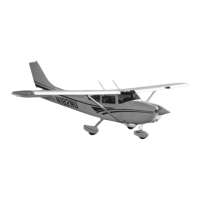CESSNA SECTION 7
MODEL T182T NAV III AIRPLANE AND SYSTEM DESCRIPTION
GFC 700 AFCS
U.S.
GROUND CONTROL
Effective ground control while taxiing is accomplished through
nosewheel steering by using the rudder pedals; left rudder pedal to
steer left and right rudder pedal to steer right. When a rudder pedal is
depressed, a spring loaded steering bungee, which is connected to the
nose gear and to the rudder bars, will turn the nosewheel through an
arc of approximately 11° each side of center. By applying either left or
right brake, the degree of turn may be increased up to 29° each side of
center.
Moving the airplane by hand is most easily accomplished by attaching
a towbar to the nose gear strut. If a towbar is not available, or pushing
is required, use the wing struts as push points. Do not use the vertical
or horizontal surfaces to move the airplane. If the airplane is to be
towed by vehicle, never turn the nosewheel more than 29° either side
of center or structural damage to the nose gear could result.
The minimum turning radius of the airplane, using differential braking
and nosewheel steering during taxi, is approximately 27 feet. To obtain
a minimum radius turn during ground handling, the airplane may be
rotated around either main landing gear by pressing down on a tailcone
bulkhead just forward of the horizontal stabilizer to raise the nosewheel
off the ground. Care should be exercised to ensure that pressure is
exerted only on the bulkhead area and not on skin between the
bulkheads. Pressing down on the horizontal stabilizer to raise the
nosewheel off the ground is not recommended.
T182TPHBUS-00
7-21

